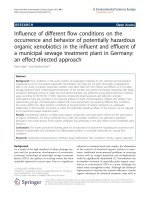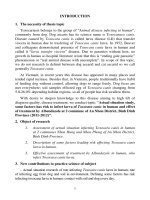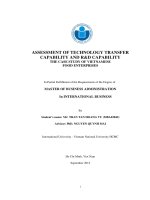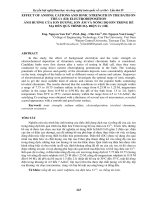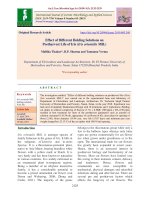Effect of different packaging conditions on shelf life of chicken samosa stored at refrigeration temperature
Bạn đang xem bản rút gọn của tài liệu. Xem và tải ngay bản đầy đủ của tài liệu tại đây (177.24 KB, 6 trang )
Int.J.Curr.Microbiol.App.Sci (2017) 6(5): 2432-2437
International Journal of Current Microbiology and Applied Sciences
ISSN: 2319-7706 Volume 6 Number 5 (2017) pp. 2432-2437
Journal homepage:
Original Research Article
/>
Effect of Different Packaging Conditions on Shelf Life of
Chicken Samosa Stored at Refrigeration Temperature
Bhaskar Kanchi, Anitha Reddy Nalla*, Naveen Kumar Reddy Metla,
Shashi Kumar Manyam and Kesava Rao Vadapu
Department of Livestock Products Technology, C.V.Sc, PVNR TVU, Hyderabad, India
*Corresponding author
ABSTRACT
Keywords
Chicken samosa,
Shelf life,
Vacuum
packaging,
Aerobic
packaging
Article Info
Accepted:
25 April 2017
Available Online:
10 May 2017
The present study was conducted to evaluate the shelf life of chicken samosa prepared
using broiler chicken (aged 8 weeks). The recipe for chicken samosa was standardized and
the product was packed in LDPE under vacuum (VP) and aerobic (AP) packaging
conditions and stored at 4±1°C.Physico-chemical, microbiological and sensory evaluation
was studied on 1, 3 and 6 days of storage. The storage period brought about significant
changes in pH, TBA value, total plate count (TPC) in chicken samosa packed under
different packaging systems. The pH was found higher in vacuum packed chicken samosa
compared to aerobic package. Total plate count values were significantly (P< 0.05) lower
in vacuum packed chicken samosas. TBA values were found higher in aerobically
packaged samosa. The sensory scores of vacuum packed samosa had higher scores for
appearance, flavor and overall acceptability when compared with aerobically packed
samosa. In conclusion, both AP and VP packed chicken samosa can be stored for about 6
days at refrigerated storage without much noticeable changes.
Introduction
India with annual production of 2.2 million
tons of poultry meat shares 2.44% of the total
poultry meat produced around the world
(Kulkarni and Naveena, 2013). The market of
processed meat is just 4-5% of the total
chicken consumption in India. So, processing
of chicken is essential to exploit its
undermined potential and can provide tasty,
convenience and designer products to nonvegetarians. Traditional meat products are
highly relished in all countries of Asia,
Africa, Australia, Europe and South America.
Chicken samosa is an indigenous and
delicious meat product of India prepared by
cooking comminuted meat with spices and
seasonings. Due to great regional diversity,
this product display variations in processing
method and sensory quality. Although
increasing urbanization and change in
lifestyle have changed in the past few years,
the liking for traditional meat products still
exists among people. Traditional Indian meat
based foods require many preparatory steps
and longer preparation time. In order to
minimize such burden of processing in the
kitchen and to cater for the needs of the
increasing working population, the demand
for ready-to-eat meat products is growing in
Indian and overseas markets. Value added
poultry meat products are being produced by
2432
Int.J.Curr.Microbiol.App.Sci (2017) 6(5): 2432-2437
some processors and marketed under different
brand names with have high consumer
acceptance.
material and stored at refrigeration for further
analysis.
Analyses of packed chicken samosa
The present study includes standardization of
recipe,
profit
evaluation,
proximate
composition and quality evaluation of chicken
samosa at aerobic and vacuum packaging
under refrigeration storage.
Materials and Methods
Meat source
Broiler chicken (n=6) of about eight weeks
age were obtained from local retail meat shop,
brought to Department of Livestock Products
Technology and hygienically slaughtered
using standard procedure. Dressed carcasses
were hand deboned within one hour of
slaughter. The deboned chicken meat were
packed in low-density polyethylene (LDPE)
and stored at -20±2°C till further use.
Preparation of chicken samosa
Formulation of chicken samosa is showed in
table 1. Partially thawed meat was minced
using automatic meat mincer by passing
through 4 mm plates (Talleres Ramon Make
P-22, Barcelona).The minced meat was
pressure cooked for 3 whistles. Cumin,
mustard, curry leaves, finely chopped onion,
ginger garlic paste, turmeric and garam
masala were fried in oil in sequence until the
raw flavor vanishes, then cooked meat was
added. Later salt, chilli powder were added,
finally chopped coriander was added. About
20 g of samosa stuff is placed in ready to use
samosa sheets (Switz Company, measured
about 10.6 x 2.7 inch size and weighed 10 g)
and shaped into regular triangle samosa.
Those filled samosas were fried in hot oil at
180oCuntil they turns golden brown colour.
Prepared samosas were packed under Aerobic
and vacuum conditions in LDPE packaging
Chicken samosas were examined for changes
in physico-chemical, microbiological and
sensory parameters during 1, 3, and 6 days of
storage. Each time three samples from each
treatment were randomly taken out. Samples
were taken for microbiological examination
first,
followed
by
physico-chemical
parameters. Remaining parts of samples were
used for sensory examination. Evaluation of
quality of chicken samosas was done from the
next day of preparation.
Estimation of pH
Estimation of pH was measured by adopting
the procedure laid down by AOAC using
digital pH meter (Elico model L 1-10 T,
Chennai) with a glass probe electrode. About
10 g of sample from each aerobic and vacuum
packed samosas was blended with 50 ml of
distilled water for one minute in a blender and
the volume was made up to 100 ml and pH
was recorded.
Estimation of proximate composition
The percentage of moisture, protein, fat and
total ash were determined as per the methods
recommended by A.O.A.C. (1984). Dry
matter content was determined by ovendrying at 103oC; total fat content was
obtained by Soxhlet extraction using
petroleum ether (B.P. 80-900c); Ash content
was determined by charring fresh sample
followed by heating in a muffle furnace for 3
to 5 h at 6000c; Kjeldahal method was used
for the analysis of total nitrogen content and
crude protein content was calculated and
expressed as percentage. Carbohydrate
content was estimated by using the following
formula.
2433
Int.J.Curr.Microbiol.App.Sci (2017) 6(5): 2432-2437
Carbohydrate (%) = 100% − % (Moisture
+ Ash + Crude protein + Crude fat)
Sensory evaluation
The organoleptic attributes viz. colour,
flavour, juiciness and tenderness of chicken
samosa were assessed by subjecting to a semitrained five-member taste panel drawn from
the staff of the College of Veterinary Science,
Hyderabad. Aerobic and vacuum packed
samosas were served to the taste panel
members as randomly coded samples and the
panelists were provided with a nine point
Hedonic score card to assess the colour,
flavour, juiciness and tenderness of the
sample.
Results and Discussion
Proximate composition
production
and
cost
of
The results (Table 2) revealed the proximate
composition of chicken samosas, these results
are corroborated with the findings of
Muthulakshmi et al., (2015) who studied the
proximate composition of samosa prepared
from spent hen meat emulsion. The cost of
production of one samosa (Table 3) was 8.55
Rupees.
pH: The VP chicken samosas revealed a bit
higher pH (Table 4) than AP chicken samosa,
this is in agreement with Muthulakshmi et al.,
(2015) who studied the shelf life of samosa
utilizing spent hen meat emulsion. Babji et
al., (2000) also reported that pH of vacuumpacked goat meat mince increased from 6.00
on day 7 to 6.10 on day 28 of refrigerated
storage. Similar findings also reported by
Geetha Chauhan et al., (2003) who made
samosas from spent hen frames meat.
TBA
Significantly (P<0.05) lower TBA values
were observed (Table 4) in VP chicken
samosa compared to AP chicken samosa.
Similar findings were reported by various
workers (Salahuddin et al., 1989; Geetha
Chauhan et al., 2003 and Muthulakshmi et al.,
2009). The higher fat content might be the
reason for higher TBA values in the samosas,
which is similar to TBA values for vacuumpacked ground beef patties (Maca et al.,
1997). Significant (P<0.05) interactive effect
between treatment and storage period was
observed in case of TBA value and as the
storage period advanced TBA values in
chicken samosa increased.
Table.1 Formulation of Chicken samosa
Ingredients
Minced Chicken meat
Onion
Oil
Salt
Ginger garlic paste
Chilli powder
Garam Masala
Turmeric
Mustard
Cumin
Curry leaves & coriander leaves
Quantity (%)
58.3
29.6
6.5
2.6
2.6
1.3
0.3
0.05
0.08
0.07
0.3
2434
Int.J.Curr.Microbiol.App.Sci (2017) 6(5): 2432-2437
Table.2 Proximate composition of Chicken samosa
Component
Moisture
Crude Protein
Total Carbohydrate
Crude Fat
Total Ash
Percentage
43.53
20.37
23.00
12.90
0.20
Table.3 Cost of production of chicken samosa with one kg bone less chicken
S. No:
1
2
3
4
5
6
7
8
9
10
11
12
13
14
15
Ingredients
Chicken Meat
Onion
Oil
Ready to use samosa sheets
Garlic
Ginger
Red chilli powder
Garam masala(Dry spice mix)
Turmeric
Mustard
Cumin
Coriander and curry leaves
Miscellaneous
Yield (number)
Cost (per samosa)
Cost in Rupees
260.00
5.00
80.00
79.50
3.15
4.05
3.49
4.50
0.03
0.25
0.35
3.00
10.00
53.00
8.55
Table.4 Effect of different packaging conditions on physico-chemical and microbiological
properties of chicken samosa
Days
1
3
6
pH
AP
VP
AP
VP
AP
VP
cA
5.19±0.04
5.94±0.01bA
5.43±0.01cB
5.98±0.06bA
TBA Value (mg Malonaldehyde /kg)
0.39±0.16cA
0.56±0.01bA
0.33±0.20cB
0.53±0.13bA
Total plate count ( log CFU /g)
1.88 ± 0.04cA
2.36 ± 0.01bA
1.63 ± 0.04cB
1.85 ± 0.04bB
6.02±0.03aA
6.07±0.07aA
1.07±0.12aA
0.84±0.08aB
2.88± 0.06aA
2.03±0.08aB
Values are Mean ± SE; (n=6). Means with different superscripts in a row (lower case letters) and in a column (upper
case letters) differ significantly (P<0.05).
2435
Int.J.Curr.Microbiol.App.Sci (2017) 6(5): 2432-2437
Table.5 Effect of different packaging conditions on sensory attributes of chicken samosa
Days
AP
VP
AP
VP
AP
VP
AP
VP
AP
VP
1
3
Appearance
6.81 ± 0.55aA
6.54 ± 1.15bB
6.80 ± 1.05aA
6.66 ± 1.21bA
Flavour
6.70 ± 1.15aB
6.67 ± 1.10bA
aA
6.86 ± 0.82
6.50 ± 0.76bB
Juiciness
aB
7.62 ± 1.43
7.47 ± 0.78bB
7.87 ± 1.65aA
7.67 ± 1.05bA
Texture
aA
7.17 ± 1.18
6.90 ± 1.64bB
7.07 ± 1.23aB
6.97 ± 1.04bA
Overall Acceptability
7.37 ± 1.23aB
7.07 ± 1.82bB
Aa
7.40 ± 1.86
7.14 ± 0.69bA
6
6.32 ± 1.47cB
6.57 ± 1.05cA
6.53 ± 1.18cA
6.47 ± 1.03cB
7.33 ± 0.35cB
7.51± 0.76cA
6.72 ± 1.75cB
6.77 ± 0.86cA
6.83 ± 1.76cB
6.92 ± 1.81cA
Values are Mean ± SE; (n=6). Means with different superscripts in a row (lower case letters) and in a column (upper
case letters) differ significantly (P<0.05).
Microbiological evaluation
Microbial counts were influenced (Table 4)
significantly (P<0.05) by storage period and
method of packaging. The SPC counts were
well within the limits of log 6.0 CFU/g
prescribed for cooked meat products (Shapton
and Shapton, 1991). Similar trend was
observed by Muthulakshmi et al., (2015) and
Maca et al., (1997).
could be prepared from chicken meat and they
could be stored in Vacuum packaging, during
storage
under
refrigeration.
Vacuum
packaging improved the oxidative stability as
indicated by low TBA number. Both AP and
VP chicken samosas are acceptable and can
be stored for 6 days under refrigeration
storage. Vacuum packaging had definite
advantage in preserving the sensory quality of
chicken samosa when compared with aerobic
packaging.
Sensory evaluation
Acknowledgments
Sensory scores of chicken samosas both (VP)
and (AP) are presented in table 5. Over all
acceptability scores were significantly
(P<0.05) differed between AP and VP
samosas. VP samosa showed higher scores
than AP samosas. Organoleptic quality found
to be reduced with storage period (from 1 to 6
days) but the samosas are acceptable at 6 day
without having appreciable changes.
In conclusion, from above study it was
concluded that acceptable quality samosas
The Associate Dean, College of Veterinary
Science, Rajendranagar, Hyderabad is duly
acknowledged for providing necessary
financial and infrastructure facilities for this
study.
References
AOAC. 1984. Official methods of analysis.
14th edition. Association of Official
2436
Int.J.Curr.Microbiol.App.Sci (2017) 6(5): 2432-2437
Analytical
Chemists,
Arlington,
Virginia, USA.
Babji, Y., Murthy, T. R. K. and Anjaneyulu,
A. S. R. 2000. Microbial and sensory
quality changes in refrigerated minced
goat meat stored under vacuum and in
air. Small Rumin. Res. 36:75-85.
Geetha Chauhan, Kondaiah, N., Anjaneyulu,
A.S.R., Mendiratta, S.K. and Keshri,
R.C.2003. Studies on development of
chicken samosa from cooked meat of
spent hen frames. Indian J. Meat
Sci.,1: 30-33.
Kulkarni, V. V. and B. M. Naveena. (2013)
Poultry meat industry: An overview on
safe food production. Processing of
XXX conference and National
Symposium of Indian poultry sciences
association. 14-15.
Maca, J.V., Miller, R. K. and Acuff, G.
R.1997. Microbiological, sensory and
chemical characteristics of vacuum-
packed ground beef patties treated with
salts of organic acids. J. Food Sci.
62:591-596.
Muthulakshmi, M., Dushyanthan, K.,
Venkataramanujam, V., and Vasanthi,
C.2009.
Physico-chemical and microbiological
qualities of buffalo meat sausages
incorporating offal meat under
different packaging methods during
storage at 4°C. Indian J. Meat
Sci.,6:46-53.
Muthulakshmi, M., Muthukumar, M.,
Rajkumar, R.S., Girish P.S. and
Mooventhan, P. 2015. International
Journal of Science, Environment and
Technology. 4: 33 – 39.
Shapton, D. A. and N. F. Shapton. 1991.
Principles and Practices for the Safe
Processing of Foods. ButterworthHeineman Ltd., Oxford, pp. 377-444.
How to cite this article:
Bhaskar Kanchi, Anitha Reddy Nalla, Naveen Kumar Reddy Metla, Shashi Kumar Manyam
and Kesava Rao Vadapu. 2017. Effect of Different Packaging Conditions on Shelf Life of
Chicken Samosa Stored at Refrigeration Temperature. Int.J.Curr.Microbiol.App.Sci. 6(5):
2432-2437. doi: />
2437
